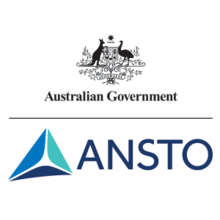Australian Nuclear Science and Technology Organisation
The Australian Nuclear Science and Technology Organisation (ANSTO) is a statutory body of the Australian government, formed in 1987 to replace the Australian Atomic Energy Commission. Its head office and main facilities are in southern outskirts of Sydney at Lucas Heights, in the Sutherland Shire.
 ANSTO logo | |
| Agency overview | |
|---|---|
| Formed | 1987 |
| Superseding agency | |
| Jurisdiction | Commonwealth of Australia |
| Headquarters | Lucas Heights, Australia 34°02′56″S 150°58′30″E |
| Employees | 1,000+ |
| Minister responsible |
|
| Agency executives |
|
| Website | www.ansto.gov.au |
Purpose
The Australian Nuclear Science & Technology Organisation (ANSTO) is Australia's national nuclear organisation and the centre of Australian nuclear expertise. The Australian Nuclear Science and Technology Organisation Act 1987 (Cth) prescribes its general purpose. The purpose is translated into action through corporate drivers of vision, mission and strategic goals.
Mission statement
- To support the development and implementation of government policies and initiatives in nuclear and related areas, domestically and internationally
- To operate nuclear science and technology based facilities, for the benefit of industry and the Australian and international research community
- To undertake research that will advance the application of nuclear science and technology
- To apply nuclear science, techniques and expertise to address Australia 's environmental challenges and increase the competitiveness of Australian industry
- To manufacture and advance the use of radiopharmaceuticals which will improve the health of Australians
Structure
ANSTO is governed by Annabelle Bennett.[1] Penelope Dobson is the Deputy Chair. The CEO, Dr Adrian "Adi" Paterson, manages the organisation.[2]
ANSTO operates five research facilities:
- OPAL research reactor
- Centre for Accelerator Science
- Australian Centre for Neutron Scattering
- Cyclotron facility
- Australian Synchrotron
Major research instruments include:
- Particle accelerator, ANTARES
- High-resolution neutron powder diffractometer, ECHIDNA[3]
- High-intensity neutron powder diffractometer, WOMBAT[4]
- Strain scanner, KOWARI[5]
- Neutron reflectometer, PLATYPUS[6]
ANSTO also manufactures radiopharmaceuticals and performs commercial work such as silicon doping by nuclear transmutation.
Nuclear reactors
ANSTO currently has two nuclear reactors onsite: HIFAR and the new OPAL from the Argentine company INVAP. HIFAR was permanently shut down on 30 January 2007. OPAL became operational in November 2006 and was officially opened 20 April 2007.
In 2017, ANTSO announced the creation of a NiMo-SiC alloy for use in molten salt reactors.[7]
See also
- Australian Radiation Protection and Nuclear Safety Agency
- Australian Federal Police
- Defence Science and Technology Organisation
- Australian Safeguards and Non-proliferation Office
References
- www.ansto.gov.au 20 November 2019
- "Media Profile: Dr Adi Paterson, Chief Executive Officer" (PDF). Australian Nuclear Science and Technology Organisation. Archived from the original (PDF) on 21 October 2013. Retrieved 20 January 2016.
- "Echidna - ANSTO". Australian Nuclear Science and Technology Organisation. Retrieved 20 January 2016.
- "Wombat - ANSTO". Australian Nuclear Science and Technology Organisation. Retrieved 20 January 2016.
- "Kowari - ANSTO". Australian Nuclear Science and Technology Organisation. Retrieved 20 January 2016.
- "Platypus - ANSTO". Australian Nuclear Science and Technology Organisation. Retrieved 20 January 2016.
- http://www.ansto.gov.au/AboutANSTO/MediaCentre/News/ACS120026